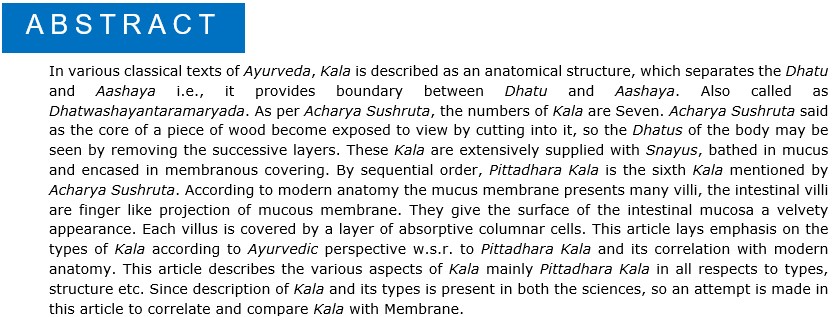Critical study of Kala Shareera w.s.r. to Pittadhara Kala with its Modern Anatomy
DOI:
https://doi.org/10.21760/jaims.9.4.35Keywords:
Aashaya, Dhatu, Kala, Membrane, Pittadhara KalaAbstract
In various classical texts of Ayurveda, Kala is described as an anatomical structure, which separates the Dhatu and Aashaya i.e., it provides boundary between Dhatu and Aashaya. Also called as Dhatwashayantaramaryada. As per Acharya Sushruta, the numbers of Kala are Seven. Acharya Sushruta said as the core of a piece of wood become exposed to view by cutting into it, so the Dhatus of the body may be seen by removing the successive layers. These Kala are extensively supplied with Snayus, bathed in mucus and encased in membranous covering. By sequential order, Pittadhara Kala is the sixth Kala mentioned by Acharya Sushruta. According to modern anatomy the mucus membrane presents many villi, the intestinal villi are finger like projection of mucous membrane. They give the surface of the intestinal mucosa a velvety appearance. Each villus is covered by a layer of absorptive columnar cells. This article lays emphasis on the types of Kala according to Ayurvedic perspective w.s.r. to Pittadhara Kala and its correlation with modern anatomy. This article describes the various aspects of Kala mainly Pittadhara Kala in all respects to types, structure etc. Since description of Kala and its types is present in both the sciences, so an attempt is made in this article to correlate and compare Kala with Membrane.
Downloads
References
Sushruta Samhita by Prof. Dr. Vasant Patil, Dr. Rajeshwari N. M. Chaukhamba Publication 2018. Shareera Sthana. Adhyaya – 4, Shloka- 5, Page No. 157.
Sushruta Samhita by Prof. Dr. Vasant Patil, Dr. Rajeshwari N. M. Chaukhamba Publication 2018. Shareera Sthana. Adhyaya – 4, Shloka- 6 & 7, Page No. 157.
Sushruta Samhita by Prof. Dr. Vasant Patil, Dr. Rajeshwari N. M. Chaukhamba Publication 2018. Shareera Sthana. Adhyaya – 4, Shloka- 6 & 7, Page No. 157.
Ashtanga Samgraha of Vagbhata Translated by Prof. K. R. Srikantha Murthi Chaukhambha Orientalia Varanasi 2001. Shareera Sthana. Adhyaya – 5. Shloka – 19. Page No. 63.
Sushruta Samhita by Prof. Dr. Vasant Patil, Dr. Rajeshwari N. M. Chaukhamba Publication 2018. Shareera Sthana. Adhyaya – 4, Shloka- 18, Page No. 160.
Charaka Samhita by Prof. Y. G. Joshi Part II , Pune Sahitya Vitarana Pune. Chikitsa Sthana . Adhyaya – 15. Shloka – 56 & 57. Page No. 459.
Sushruta Samhita by Prof. Dr. Vasant Patil, Dr. Rajeshwari N. M. Chaukhamba Publication 2018. Shareera Sthana. Adhyaya – 4, Shloka- 19, Page No. 160.
Manipal Manual of Anatomy for allied health science courses, Third Edition, 2016. Page No. 236
Ashtanga Samgraha of Vagbhata Translated by Prof. K. R. Srikantha Murthi Chaukhambha Orientalia Varanasi 2001. Shareera Sthana. Adhyaya – 5. Shloka – 23. Page No. 64.
Sushruta Samhita by Prof. Dr. Vasant Patil, Dr. Rajeshwari N. M. Chaukhamba Publication 2018. Shareera Sthana. Adhyaya – 4, Shloka- 8 to 20, Page No. 157 to 160.
Sharangadhara Samhita by Dr. Brahmanand Tripathi, 2016. Adhyaya – 5. Kaladikakhyanam. Shloka – 8. Page no. 38.















